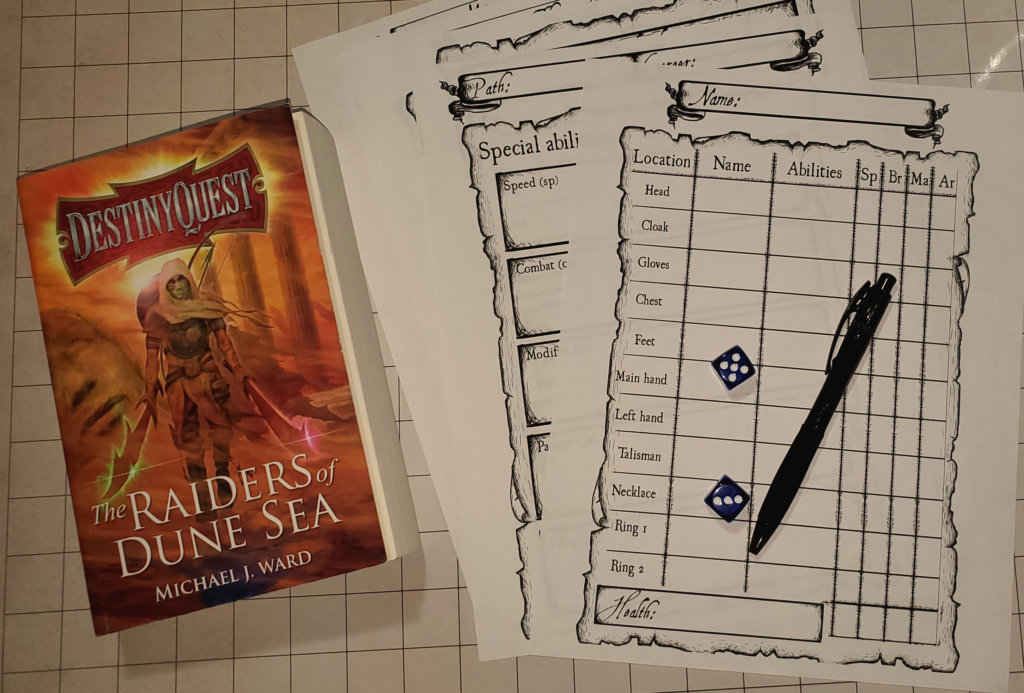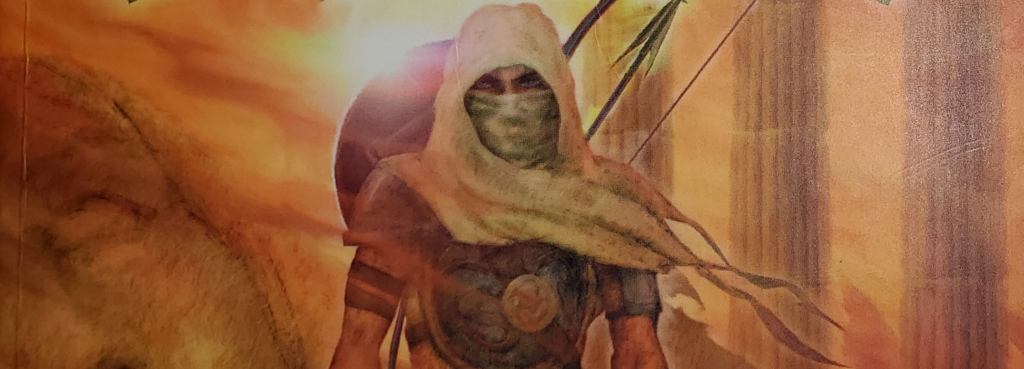
Greetings, fellow adventurers! Today, we delve into the thrilling realm of Destiny Quest with a review of the latest installment in the series, The Raiders of Dune Sea (Raiders) by Michael J. Ward. Raiders is the first book in the Sands of Time trilogy and the fourth book overall in the Destiny Quest series. If you haven’t read the three preceding titles, don’t worry. It isn’t necessary to enjoy this one. Raiders begins a whole new story. The next title in the series – The Wrath of Ragnarok – will be released shortly.
Destiny Quest has solidified its position as one of the modern frontrunners in this space that blends gamebooks and more traditional role-playing. Raiders upholds the high standards of its predecessors. This series stands out for its unique combination of traditional storytelling and role-playing mechanics, offering players a dynamic and interactive experience that bridges the gap between literature and tabletop gaming. There are other gamebooks with more extensive game mechanics than Fighting Fantasy and Lone Wolf, but not many are as extensive as what you will see here.
The first word that comes to mind about Raiders is epic. This is not your typical spend an hour or two flipping pages and making choices kind of gamebook. This thing is huge and the story is grand. If you’re an old role-player like myself, this isn’t an adventure – it’s a campaign. Clocking in with 874 passages across 696 pages, this is the textually largest gamebook I’ve ever finished. Not only are there many passages but the passages themselves often run on multiple paragraphs and sometimes even multiple pages. It is printed on fairly typical paperback size pages and the print density is easily two or three times the words per page from most gamebooks. I am being completely serious when I tell you that you shouldn’t pick this up lightly with the intention of filling a little time. Starting this book is a commitment – a worthwhile one but a commitment nonetheless.
The Story
Raiders takes us on a journey through an expansive and immersive world. The writing is polished and engaging. It is published by Matador, a traditional book publishing company, instead of the typical print-on-demand indy titles you see in this space so it has had the advantages I’m sure of professional quality editors and proofreaders and it shows.
I don’t want to give too much away but your character begins as an orphan who has been hunted by the Church because of some special powers. Over the years you’ve become part of a motley crew of adventurers making their way in the world. Something destroys that bedrock of stability. A betrayal shakes your character to the core and leads them on a quest for vengeance. This subtext underlies much of the first half and part of the second. The book itself is divided into two acts: The Badlands and The Dune Sea. Your character travels from the coast through broken-down towns, badlands, and eventually an unforgiving desert full of ruins, sand pirates, and political factions.
Multiple plotlines are threaded together among several smaller quests with breadcrumbs leading toward the overarching story. There is a wide cast of well-developed non-player characters (NPCs) who show up persistently. They each have their own goals and desires and in some cases ulterior motives. When some events take place, you are instructed to write down different codewords. In many situations, this helps to identify past dealings with an NPC so their future reactions to the character can change because of past interactions. This goes a long way toward helping the characters seem more interesting and more three-dimensional. The same applies to events in the adventure that are influenced by past events.
Raiders also employs a map to help characters move across the countryside. There are encounters labeled on the maps and you can go through them in any order within the act as you choose. This provides a lot of latitude in how you play but some require you to complete certain tasks before you can attempt them. There are also some fairly major encounters or quests that do not show up on the map at all and you have to learn about them during the adventures.
Gameplay
The Destiny Quest series is closer to traditional role-playing games from a mechanics perspective than rules-lite gamebooks. Some people will like this and others may not. It adds flavor as well as complexity and can also make combat require more paperwork and time than simply making a die roll or two.
Characters have five basic attributes (Speed, Brawn, Magic, Armour, and Health). They start at zero except Health which starts at 30. From a typical RPG perspective, Speed and Brawn are a lot like Dexterity and Strength. Health works a lot like hit points. Characters lose Health points when they are wounded. They typically return at the end of a combat session, but if they drop to zero the character dies. Dying just means you go back to the map and restart the last encounter like a save point in a video game. Armour lessens damage that the character would receive from an attack – which I personally prefer to the typical “making it harder to hit” Armor Class rules you see in most games.
Characters start out as a more or less blank slate. Along the way, players choose one of three primary paths – Mage, Rogue, or Warrior — for their character. I played as a Rogue. Each has strengths and each path can influence the story in different ways. You run into NPCs who can train your character in careers along the way too and your character can change careers but not paths.
The game relies very heavily on equipment – perhaps a bit too heavily. Different pieces of equipment you find, earn, or buy along the way provide bonuses to your basic attributes as well as granting special abilities that are used in different situations. From my experience, most of the character improvements come in the way of equipment. Finding good equipment is critical. In most tabletop RPGs, having good equipment helps but there are ample opportunities to improve skills and attributes. Here the balance seems to swing a lot harder in the direction of the gear. As the character sheet shows, any item can provide bonuses to any of the primary attributes as well as providing special abilities. Some of the bonuses seemed a little arbitrary at times.
The special abilities bring some interesting flavor to the game; but, they can be a bit tedious to keep up with. They can come into play in many ways. Sometimes they just force something to happen. Sometimes they give bonuses in attacks or the use of magic or sometimes it’s like that but only in specific circumstances or during the first round of combat etc. You really have to keep up with them and then you upgrade a piece of equipment and have to remember the new one and where it fits. Yes, I’m lazy, but the bookkeeping (i.e. documenting everything) can feel a little like work sometimes. Bear in mind, this is a really long gamebook. Much of the documentation and notes etc. are because there are so many opportunities for things to happen. Even though it felt like work sometimes, it adds so much to the experience that I think it was worthwhile.
Combat is another area where things can get a little complicated in a good way. The basics of combat are easy enough. There are rolls to attack and damage and Health is reduced etc. until the character or the monster dies. Often though there are things that happen in some rounds that don’t happen in others. Tactics can change and special attacks or abilities can come into play in a way that is a little more complicated but it adds so much flavor and variety that it’s really much better than the typical roll the dice until something dies way of doing things. This is a really hard thing to deal with in a gamebook because you don’t have a gamemaster who can change things on the fly. This helps to give the game some variety and improve the basic tedium that combat often brings. That said though, it can make combat encounters take more time.
Presentation
The only real art in the book is the front cover and the color maps for each of the two acts that appear in the inner cover. There are some iconic type pieces of art as fillers and some puzzles with minor illustrations but that’s it. Many of the scenes would lend themselves to illustrations so I would hope sometime in the future they add some additional art. The cover art is good but not great. Coming from a traditional publishing house though, if you look closely you might expect better. It’s not bad but there are several indy gamebook titles with much better art. Still, it doesn’t take away from the text. The maps are pretty neat to look at — I’m looking around to see if there’s a way to get them as prints. If you happen to find a way, please drop me a note at retroroleplayer@gmail.com.

The text itself is laid out clearly and is very space efficient. Matador – the publisher – really squeezes a lot of words on a page. I have the first three titles in the series on Kindle and I must say my tired old eyes appreciate the ability to increase the font size (the hyperlinked passage numbers are a real treat there too). If you’re an old fart like me, this might influence the medium you choose.
Overall
As you can tell by now, I’m definitely a fan. Ward does a great job setting up a unique world with interesting characters, intriguing settings, and lots of plot twists. The prose definitely helps bring this world and its characters to life. The rules and game mechanics add a considerable amount of flavor to the adventure and help to bridge the gap between gamebooks and RPGs in some very positive ways. If you are looking for more of a role-playing experience, I don’t think you will be disappointed.
One of the defining features of Destiny Quest is its replayability. With multiple branching paths, alternative storylines, and variations depending on the character’s path/career and previous encounters, each playthrough offers a fresh experience. Additionally, the book’s huge number of encounters and expansive world encourages multiple explorations, ensuring hours and hours of adventure.
Destiny Quest: The Raiders of Dune Sea is a professional, masterfully crafted gamebook that will captivate fans of the genre and newcomers alike. The only word of caution I would give a reader is to be prepared for an engaging, immersive experience but also be prepared to invest a little time and effort. It will pay off in the end.
Note: Trademarks, titles, and example artwork from reviewed titles or others referenced are used for illustrative and editorial purposes only. No ownership of those or their trademarks is claimed or disputed by Retro Roleplayer.
